




 |
 |
 |
 |
 |
DEVELOPMENT |
ONLINE
PROJECTS |
|||||
Waxes
suitable for Encaustic Artwork |
||||
| TERMS | ||||
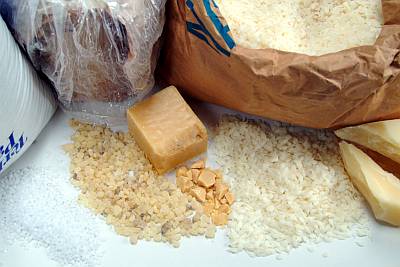 PARAFFIN : DAMAR RESIN : CARNAUBA : BEESWAX : MICRO CRYSTALINE Some of the main waxes used in basic encaustic formulation. |
Encaustic
paint needs to contain wax & colour. |
|||
The simplest encaustic paint
could be a basic mixture of beeswax and an earth pigment. However,
there are many other types of waxes, each with their own unique heat
curve and character. There are also resins that can be mixed with waxes
to alter final working qualities of melting point, flexibility, hardness,
adhesion & durability.
Pigments (and dyes) offer a multitude of qualities apart from the colour
they imbue. The particle size can change the flow character quite dramatically
for some application methods. There
are many possibilities in formulation. NOTE: All information here is just a starting point - the www has loads of in-depth data on waxes, pigments and everything else, so please research it a bit more to clarify the notes below. |
Primary waxes often used for encaustic medium involve: BEESWAX, |
|
|
|
Definition of WAX : Any of various substances of either mineral origin or plant or animal origin; they are solid at normal temperatures and insoluble in water. OR Any of various natural, oily or greasy heat-sensitive substances, consisting of hydrocarbons or esters of fatty acids that are insoluble in water but soluble in nonpolar organic solvents. Beeswax is a natural product produced by young bees in the form of wax scales. Melt point around 62C. They reckon 8 volumes of honey are eaten to each unit of beeswax secreted, and also estimate that around 150,000 miles of bee flight are required to harvest 1lb of beeswax - precious indeed! Refined beeswax, that has had all the impurities removed, often comes in pelleted form. It is a bleached cloudy whitish colour, but given sufficient time this will apparently harden and yellow to some degree or other. There are various
qualities of natural beeswax It's most natural raw state is where
it has been separated from the honey and the main dross. It still contains
some oils and dirt, so can be blotchy if used for artwork. Electrical
heating is used to commercially process beeswax, but solar heating is
more gentle. In the latter method the beeswax can be put through a solar
unit many times, each one helping to refine the wax without exposing
it to any danger of over-heating. Modern commercial methods are very
reliable. |
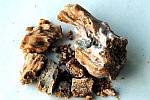 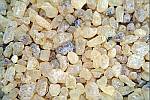 |
Damar resin comes from a particular tree in Asia. This sample was collected in the Malaysian rain forest. It is refined to produce crystals that have a melting point around 80C. Some damar is whiter and therefore more suited to clarity of colour in encaustic mediums. It is preferred over Mastic because it does not have the same bloom issues. (white powdery surface effect- a bit like settled dust.) It can contain quite a bit of woody dross. In encaustic medium it raises the melt point, toughens the wax surface, improves both adhesion and flexibility. It can smell quite strong when molten - always ventilate the area. |
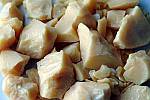 |
Carnauba wax is also a natural tree wax, this time scraped off the leaves of a Brazilian palm tree. It polishes to a high sheen. It melts around 80C and is very brittle; hit it with a hammer and it shatters! For this reason it is less popular in encaustic medium than damar resin. However, it can work very well despite adding a brittle quality and does avoid the need for a resin. A small amount can be added to a damar mix to improve the final sheen of a finished encaustic painting. It is an option. |
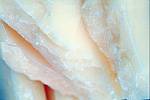 |
Microcrystalline Wax is a petroleum based wax that has very different physical properties than paraffin wax. Micro wax is more dense and chemists tell us it has closer packed molecules. When liquid it has a higher viscosity than paraffin and is more flexible. It demonstrates better adhesion, has a tougher surface and has a higher melt point than paraffin wax too. There are many qualities - often used for thick impasto effects. |
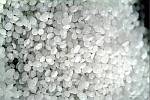 Up to Index |
Paraffin wax is a petrochemical product. It is used in industry and often for candles. It has a pleasant cloudy white colour and our samples melt around 55C although it can be mixed to different melt point too. One big negative is the shrinkage it displays once cooled. This can cause cracking or on weaker support materials can cause buckling. Often not recommended for artwork, it is cost effective and for large pieces can give interesting results. A lot depends of your concerns regarding durability & permanence. If they are paramount don't use paraffin wax - but it can have its place too. |
Whilst the above are the
most commonly used waxes in encaustic mediums there are others that can
imbue different qualities. Experimental encaustic work does not
define itself by longevity nor gallery praise. It rests on its own finality,
on its own record of a journey through processes & ideas explored. Potential
neither recommends nor excludes - it just explores openly. |
|
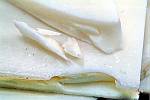 |
This commercially manufactured wax was a microcrystalline based one. It is no longer made but they would not release the formulation - a pity because this mixture was great for impasto work and could happily be laid on 10mm to 20mm thick if desired. Still, maybe in the future other manufacturers will create new encaustic wax mediums with alternative qualities to the conventional beeswax and damar resin mixtures that are currently seen and held as the "ideal" standard.. |
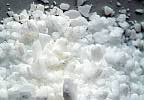 |
Polyethylene waxes are manufactured from low molecular weight, high-density raw materials. Used in many industrial situations they have the wonderful possibility of being created with melt points ranging from 50C to 150C. So you can imagine how this stuff can influence the melting and handling of other waxes, including encaustic mediums. An interesting idea is to use several different melt point mediums in the same piece, then work them with hot air tools to temperature sculpt through the various layers and textures - can be good! |
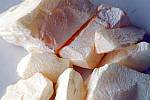 |
Japan Wax is not one that looks very useful. It is cited as a substitute for beeswax in polishes and so on. It melts around 53C so is low. It is on this page to demonstrate the sort of wax surface look to avoid, unless of course you want random crusty white icing sugar effects in your work. It is a natural wax but without some experiments we can comment here no further at this time. |
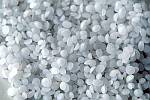 |
Paraffin Wax has already been mentioned above, but it deserves a bit more space, simply because there are so many options within the paraffin and microcrystalline wax area. The melt points readily available (in the UK at least) range from around 40C to 70C. The fully refined wax is a white colour, similar to the sample shown here. |
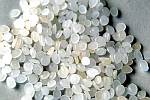 |
Clearer more translucent varieties are also available. So for some types of transparent work these varieties may be more useful. As already mentioned, where durability is important, especially in gallery fine art, where investment requires the work to remain close to its original state, then paraffins are usually not recommended. But candles seem to stay in good condition and they are paraffin wax, so how permanent do you need (and in the end how permanent is permanent anyway) ? |
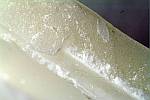 |
Paraffin Wax comes in slab form too. These slabs weigh several kilograms each. They can be broken to fit them into a melt pot. One of the major problems of paraffin wax, apart from shrinkage issues and low melt point, is that the wax, when cold and at normal room temperatures, is relatively brittle and thus liable to chip or break So on any flexible surface it has potential to literally fall to pieces. So use with careful consideration! |
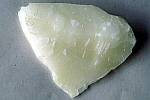 |
Microcrystalline waxes also get a bit more said here. This wax group are finer in their crystalline form, so provide a denser and more flexible material. Tackier and more elastic than the paraffin group they are more useful and more reliable for artistic projects. They are tougher, so are better suited to resist knocks, scratching and flexing. There are hard and soft varieties with a good range of melt points available too. They do tend to be opaque. |
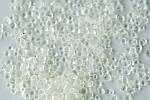 |
Plasticiser is a synthetic product used in candle making to reduce the brittle qualities within paraffin wax. It makes the wax go more pliable at temperatures just below their melting point and makes the final wax thicker once melted. In candle situations it is often added to enable sculpting of the candle's outer form whilst it is still warm. Paraffin wax used for impasto work would benefit from this addition and it also has a higher melt point, so that is always a bonus for durability of encaustic surfaces in warmer climes. |
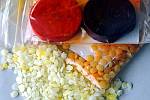 Up to Index |
Stearin is also a candle making product and is added to the paraffin wax to increase shrinkage upon cooling. This is useful to candle makers for assisting release from molds. It is white and flakey in form, although it may be purchased as pellets. If cracks and alternating wax qualities are being used to create differing "freezing points" and shrinkage values then it might find a place in your collection of waxy materials. NOTE: the candle dyes shown in the image have leached through the plastic bag into the wax. Candle dyes are very invasive in this respect. |
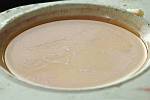 |
Liquid wax, held at a safe temperature in a metal welled palette (muffin tin) on a temperature controlled hotplate. Colour has been added, so this is an encaustic paint ready to use and ideal for brushes work. Check below for the terms relating to states of wax to discover more about the amazing transition from solid to liquid and the reverse. DO NOT OVERHEAT!!!! |
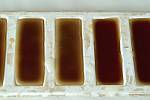 |
As wax cools it first congeals before then freezing. It is still more pliable the closer it is to that freezing / melt point. You can see the transformation happening here as the wax is cooling in the molds faster at the edges. The inner wax can still be molten when the outer surface has solidified, so it is always wise to place any cooling wax in a location where it will chill through before trying to de-mold it! |
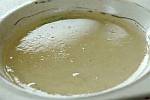 |
Congealed microcrystalline wax is quite workable on a suitable support surface and will hold form rather than continually seek to level out like a liquid would behave. This state makes it interesting for more impasto textured pieces. The drawback is that the congealed wax will freezing into a solid very easily on contact with a surface or tools that are too cool, but you can pre-warm these to lessen the problem.. |
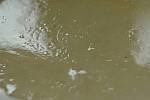 |
The congealed wax is also interesting in that you can partially blend in pigments and other objects like sand or, well anything that you want to embed or envelop in the wax. Collaged layers, dimensional forms, many possibilities. The congealed state is a narrow temperature band though, so operations need to be carefully considered. The wax is still pretty hot too! |
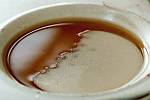 |
A beeswax and damar encaustic medium in partial molten state. Here you can see the transition from solid to liquid, as the wax passes through the congealed temperature zone into its liquid form. It is important not to overheat waxes. Apparently this can affect their chemistry and cause them to be more brittle once cooled. The waxes should never exhibit "fuming". |
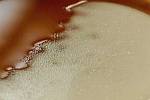 |
Fuming relates to ANY VISIBLE smoking or fumes. If you heat with well controlled apparatus or a double boiler (water skin prevents overheating) then all remains in a safe operating mode. As the wax melts the liquid part next to the container can get quite a bit hotter than the melting edge of the remaining wax solids. |
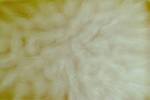 |
An interesting pattern on cooling wax that clearly shows the temperature and state differences around this small temperature band where the liquid is first congealing bore setting into its solid structure. Waxes in bigger molds can take a long time to thoroughly cool so best to leave them to chill overnight if possible. |
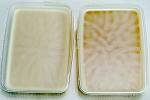 |
Microwave containers are handy for pouring and storing wax medium. Some plastics are not suitable for heat usage. These smaller wax blocks of medium can later be remelted when requires and mixed with pigment as needed. |
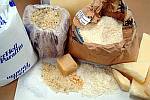 Up to Index |
Wax in its solid state will remain in good condition for many years. Keep it dry and cool, away from hot moist dusty atmospheres for best results. If bloom forms then heating beeswax above 38C will cause it to disappear. You can run warm water or blow it with a warm (not too hot) hairdryer. Always buy the best quality waxes you can afford. Don't overheat them. Process them with care. |
Melt Point : The melt point of a wax is the temperature that it starts to turn from a solid to a liquid, or from a liquid to a solid. Flash Point : Temperature at which an excessively heated wax begins to vaporize and becomes a volatile gas. The vapors from molten wax are extremely flammable. Individual waxes have a specific flash point - check suppliers for this information. When it reaches its flash point it may not smoke or bubble, it can just explode, splattering flaming wax in all directions. Don't use open flame burners to heat wax. Use controlled devices or ideally the double boiling method to melt your wax. Water boils at 212° F, which is well below the flash point of all waxes we have experienced. As mentioned - check for technical information from your manufacturer or sourcing supplier. Freezing Point : The freezing point is an established point 2 to 3 degrees below the melting point. A solid wax will remain solid, at varying hardness, as long as its temperature remains below the freezing point. Congealing Point : Temperature at which a wax begins to harden into a solid form. At the congealing point, liquid wax will cease to flow under specific conditions. Cloud Point : Temperature at which a wax begins to change color from clear to opaque. The cloud point is an undefined point, from 2 to 3 degrees above the melting point, to 10 to 50 degrees above the melting point, depending upon the grade of wax and the types of additives in the wax. The cloud point is the temperature where liquid molten wax is beginning to change structurally and visibly from liquid to solid Viscosity : Ability of wax to resist flow. The viscosity of wax is represented by a number that defines how a particular wax will flow at a certain temperature. The temperature and the viscosity of wax have opposing relationships. The higher the temperature, the lower the viscosity, and the lower the temperature, the higher the viscosity. This means that a hot wax has a low viscosity and will flow better than a cold wax with a high viscosity. Needle penetration : The hardness of a wax is measured by a standardized process called "needle penetration." It is an indication of how far a needle can penetrate the wax at a temperature of 77° F. The higher the number, the softer the wax; the lower the number, the harder the wax. The penetration numbers vary from 1 to 14 (hard waxes), to 15 to 25 (soft waxes). Wax Colour : Color of a wax at a designated
temperature. The test is usually done while the wax is in liquid form.
The color is determined by comparing the wax color to a standardized
assortment of gage samples (Saybolt test). The color gage samples range
in color from a low number, (i.e. + 2, clear amber while molten, dark
amber while solid), to a high number, (i.e. +30, crystal clear while
molten, pure white color while solid). Generally speaking, the higher
the color number, the lower the impurities in wax . Almost all food grade
waxes have a color of +25 or greater. |
|
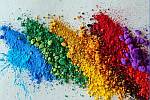 Up to Index |
Visit this section to learn more about pigments. |
...
AND THERE ARE MANY READY-MADE ENCAUSTIC WAXES AVAILABLE
TOO ! |
|
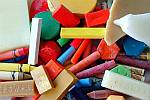 |
READY-MADE ENCAUSTIC WAX COLOUR PAINTS Visit this section to see a selection of some of the ready made encaustic wax products "out there". Not all will be available in your area. Some are no longer even made, but it tries to show a range of what is going around. |
encaustic.com offers the Encaustic Art range of wax block colours because they are effective and safe in use. They are used worldwide by all ages and abilities without toxic risk. Through instantly achievable techniques the interest and experience of encaustic art continues to spread with excitement and many satisfied users. These purpose made encaustic art wax blocks are made to the highest standards possible and are designed to be safe to use by anyone. The pigments are as light-fast as possible yet still meet the strict toxic controls demanded and implemented in the USA. They are labeled with the CL health label (caution label) which means that the waxes are safe in content but care needs to be observed when using them with the heated tools, simply because these heated implements might inflict light burns if carelessly handled. The waxes themselves are considered and tested by a professional USA toxicologist at "Duke" as safe. However, we are very
aware that they do not suit all needs nor meet all demands. In
respect of that we have used the experience of Michael
Bossom to furnish
this whole artwork area with some further approaches and materials. Here
you can find information to help guide your own exploration in to making,
colouring and using encaustic wax medium and encaustic paints successfully.
|
|
|